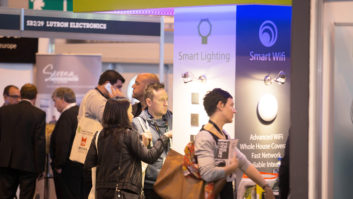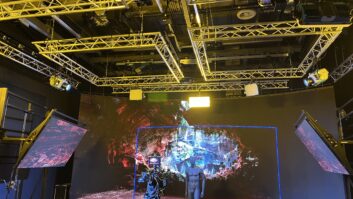The familiar story of AV being considered too late in the design process often still holds true, but developments in attitudes and tools are promoting a more integrated approach, writes Steve Montgomery. (Picture: the University of Exeter’s The Forum: a hub space containing student facilities and teaching accomodation).
Technological advances in the audiovisual world happen, as we all know, extremely quickly. Cast your mind back five years: the use of flatscreens, TV and video distribution, even the internet was nowhere near as common in buildings as it now is. The systems that were installed in videoconferencing suites, reception areas and presentation rooms were far simpler and bear little resemblance to those of today. Not only have AV professionals had to learn new techniques and handle displays of ever-increasing size, but so too have those responsible for selecting and designing the buildings that accommodate them.
It is hardly surprising then, that architects find it hard to keep on top of developments in the AV industry and to allocate the level of detailed design and consideration that they do for other, more traditional construction tasks. This is exacerbated by the fact that a building may take two years or more to progress from concept to completion and the technology will move on considerably in that time.
FIT FOR PURPOSE
The success of a building is measured by how well it fulfils its intended function; be it work or leisure, technology is just one aspect of the experience that is the interaction between people, the processes and the place. It is how well these three factors are integrated together that govern the user or visitor experience.
The design requirements of a building are related to its purpose. “Architects often pay too little attention to the functional requirements the client has for a building, leaving the design of technology and services until it is too late to fully integrate them into the architecture,” says Duncan Howie, lead consultant for strategic consultants Visual Acuity. “Only such an integrated building, be it for work or leisure, will deliver its full potential and I firmly believe that effort invested early in the project pays dividends through the project delivery and ongoing operations,” he explains.
“All too often, architects don’t design for functionality, or they assume that technology can be configured to deliver what they perceive as functionality sometimes without even establishing the actual functional requirements with the client. This, I find, is because they don’t ask the right questions. I think this is a combination of not realising the potential of modern technology and its applications, and not being open to learn about it.”
This approach may be intentional to protect the aesthetics of the building, but invariably results in the building not achieving its operational potential and audiovisual systems looking like an afterthought. However, such compromises can be avoided by embracing a broader base of specialist consultants to collaborate from the initial concept stage so that technology is designed to facilitate the intended processes and is wrapped in architecture to create the desired environment.
Sometimes technology itself is seen as the panacea to all physical design ailments. “People seem to think that technology is good enough to fix it all – no matter what ‘it’ is,” says Graham Naylor-Smith, associate director at Arup. “But it isn’t. You still need good lighting, good acoustics and good room layouts to make the technology work at its best.”
Rajesh Sinha, director of smart building & energy efficiency solutions at Accenture, concurs: “Our role is to explain the ‘art of the possible’ to building owners and advise the architects on the ever-increasing levels of technology within buildings, including AV, HVAC, lighting and smart controls. This needs to be related to the lifetime of the building and how technologies might change over periods of 25 years or so. We aim to establish a framework for the delivery of services, without being too specific and leaving headroom for growth over the years.”
we can help
So these are areas where specialist consultants and AV professionals can advise and assist – InfoComm, for example, provides training seminars to architects as part of its ongoing training and development. Chris Lavelle, regional director for UK and Ireland at InfoComm, says: “We offer a series of seminars for RIBA (Royal Institute of British Architects) covering aspects of partnership between architects and integrators, AV standards and best practice so that architects can become more aware of the elements and procedures in achieving high-quality audio and video installations. The response to them is good: architects become more open to the needs of the AV community and more sympathetic to the problems of AV installation. We are making headway, but there is still a long way to go.” This is particularly an issue in corporate and commercial building design, less so in the public sector, universities and museums.
@page_break@
(Picture: The humanities building at Queen Mary, University of London)
InfoComm’s imminent Audiovisual Systems Performance Verification standard (currently in draft) provides the framework from which any and all systems can be verified. According to Ann Brigida, director of standards for InfoComm International: “An architect should be working with an AV consultant, designer or integrator who will use this list to design the system to agreed-upon functional requirements and design. In this way, the installer is actually verifying that what was promised is being delivered through specific phases of the project that have been mapped out and put into an organised plan. It’s the perfect tool for everyone involved if it’s used correctly.”
Jon Melchin, director of architectural business development for AV product developer FSR, conducts presentations for the American Institute of Architects (AIA) Continuing Education Series: “There is often a ‘disconnect’ when it comes to architects and AV,” he says. “So we try to educate and encourage architects to recognise the importance of AV infrastructure and its impact on the performance of the building. I try to emphasise that AV technologies are considered business-critical systems, and early planning is beneficial. Once the walls go up, AV systems become difficult to integrate as an afterthought, but it still happens. The challenge is getting everybody on the same page on this – architect, AV consultant, AV systems integrator, electrical contractor, and the facility owner. It’s advisable to bring AV into design discussions as early on as possible in the applicable phase.”
One of the major issues presented by complex AV equipment is the rapid evolution and pace of obsolescence of AV products; new equipment appears that is immediately attractive to building owners. “We have learned to work closely with AV specialists from the earliest stages of a project in order to jointly specify and understand the limitations imposed by this type of technology – for example, the constraints in projector positioning and acoustic treatments, and how we facilitate these in ceiling and wall design,” says Tony Musson of Wilkinson Eyre Architects. “However we are often hit by late changes imposed by new technologies and devices requested by clients who want state-of-the-art technology. As a result architects are hesitant to specify exactly the devices when design starts, often two years or more before completion. It is sometimes difficult to add a new or additional type of device to a finished room without it looking like it has been included as an afterthought. Interactive whiteboards with their short-throw projectors are a typical example, exacerbated by the need for services to them which might only be able to be run on the surface at that stage.”
Step by step
Project planning and timing is defined in RIBA’s plan of work; a ‘definitive model for the building design and construction process’ which identifies eight stages (0-7) in a project. “AV systems should ideally be laid out in principle by stage 3 – Developed Design – and the physical items should be specified by stage 4, Technical Design,” explains Naylor-Smith. “While device models and types might change before final installation, parameters such as screen size and speaker position can be agreed.”
To some extent, AV integrators have to take control of the situation and ensure that architects and building project managers are made aware of the techniques of AV integration as well as providing complete information on the systems proposed. One way of doing this is to embrace Building Information Modelling (BIM): a process for the generation and management of digital representations of buildings.
Computer models cover the physical and functional characteristics of a facility from the earliest conceptual stages and through construction, and act as an ‘owner’s manual’ for the building. Architects are very familiar with BIM and use it to generate 3D images of a proposed structure to visualise the final result. It is rapidly becoming a tool that is crucial in checking aspects of the design, particularly interaction between disparate elements and offers an effective way for AV integrators to collaborate and work with architects.
“BIM has become increasingly instrumental in drawing various parties together to share information about a building, its components and the energy-efficiency performance of the intelligent environment,” says Melchin. “AV providers can bring valuable input to the project and communicate it through BIM modules. There are many architectural and structural decisions to be made that will affect cable pathways, camera and projector sightlines, and natural daylight designs that can compromise video clarity. Building Information Modelling is an excellent tool for designers who can use the models to visually check the final result. Among other benefits, BIM fosters collaboration between everybody working on the project.”
For the time being though, it is unlikely that BIM will be used extensively for small AV components. Large flatpanel displays and external stadium screens that affect the structural design of the buildings by requiring dedicated mounting consideration will be included, and so too will the allocation and access to equipment rooms – another AV (and IT) requirement that is often neglected or inadequately provided for in building design.
Smart buildings
AV integrators also ignore the trend for ‘smart buildings’ at their peril. “Forward-thinking construction companies and mechanical and electrical contractors are implementing smart building technologies,” points out Rajesh Sinha. “As the cost of smart technologies continues to fall and their benefits become more apparent, the decision to implement smart building technologies is increasingly straightforward. Energy, maintenance, comfort and other benefits, requirements for future-proofing, along with an increasingly strong return on investment, make smart technologies particularly attractive for both new-build and existing buildings. Clients and those responsible for the ongoing comfort and costs of operating a building are demanding a smart approach: buildings in which the lighting, AV, shades, heating, cooling and ventilation operate seamlessly and optimally throughout the year, adapting to public holidays, seasonal variations and changes in use, without ongoing manual tuning throughout a day, week or year.”
Modern buildings are complex, but the design team should be managed so as to facilitate co-operation and rise to this challenge so that the end result is an efficiently functioning environment. We’ve been constructing buildings for long enough; we really should be getting this right by now. Not rushing ahead too quickly without investing time and effort in the concept stage pays dividends throughout the project and on through the operating life of the building.
“I guess some contractual arrangements encourage people to push on with their own specific deliverables without pausing to collaborate effectively,” says Howie. “That includes deciding how integrated the systems need to be to function effectively; it does not need to be more complicated than appropriate for the particular requirements of the building’s operation. An independent consultant will overcome this pitfall.”
www.accenture.com
www.arup.com
www.fsrinc.com
www.infocomm.org/standardreview
www.riba.org
www.visual-acuity.com
www.wilkinsoneyre.com







